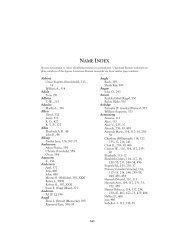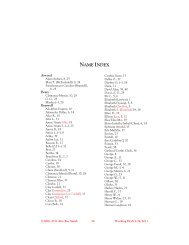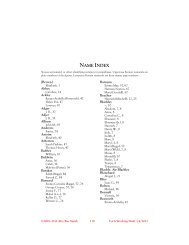Fall 03 newsletter - Alvy Ray Smith Homepage
Fall 03 newsletter - Alvy Ray Smith Homepage
Fall 03 newsletter - Alvy Ray Smith Homepage
You also want an ePaper? Increase the reach of your titles
YUMPU automatically turns print PDFs into web optimized ePapers that Google loves.
Generations of Creativity:<br />
Celebration of the Durand Family<br />
Nov. 16, 1-4 p.m.<br />
Durand family historian and Academy<br />
Award winner Dr. <strong>Alvy</strong> <strong>Ray</strong> <strong>Smith</strong> will be<br />
the featured speaker at a celebration of the<br />
renowned Durand family at an open house at<br />
the Durand-Hedden House on Sunday,<br />
November 16.<br />
Dr. <strong>Smith</strong>, co-founder of Pixar Animation<br />
Studios and a two-time Academy Award<br />
winner for his computer graphics<br />
innovations, has published a history and<br />
genealogy of his<br />
illustrious ancestors,<br />
Dr. John Durand of<br />
Derby, Connecticut and<br />
His Family, with the<br />
New England Historic<br />
Genealogical Society.<br />
On exhibit at the House for the first time<br />
will be items from the Cyrus Durand<br />
Chapman Collection of letters, artwork,<br />
photos, a diary and memorabilia from early<br />
Durands who lived in Maplewood and its<br />
environs beginning in about 1740. Also<br />
Newsletter<br />
Durand-Hedden House<br />
And Garden Association<br />
Vol. 22, No. 1 November/December 20<strong>03</strong><br />
CALENDAR<br />
Sun., Nov. 16 Durand Family Celebration 1:00-4:00 pm<br />
Sun., Dec. 7 Postcards From the Past 1:00-4:00 pm<br />
Sun., Jan. 18 Maplewood: A Treasury of American Architectural Styles 1:00-4:00 pm<br />
exhibited will be items donated by Durand<br />
descendant Jane Virginia Bauch.<br />
A number of<br />
descendants of the<br />
Durand family are<br />
expected to attend.<br />
The most famous<br />
Durand known today<br />
is Asher Brown<br />
Durand, one of the<br />
founders of the<br />
Hudson River School<br />
of painting. The<br />
Durand-Hedden House is fortunate to own<br />
three of his original works – a field study for<br />
one of his nature paintings (given by John<br />
and Fran Apetz), and<br />
portraits of his brother<br />
Cyrus Durand and<br />
Cyrus’ wife, Phoebe<br />
Wade Durand (given by<br />
Nadine Gallagher<br />
Chapman), all of which<br />
have hung in the<br />
Durand-Hedden House<br />
parlor since their<br />
donation in 1989. In<br />
addition, as part of the
Nov. 16 exhibit, the Maplewood Memorial<br />
Library will lend us another of Asher’s works<br />
as well as a painting of the Durands’<br />
Maplewood birthplace by Asher’s nephew,<br />
artist and horticulturalist Elias Wade<br />
Durand (1824-1908).<br />
The Fruits of Research<br />
On Nov. 16, Dr. <strong>Smith</strong> will share stories and<br />
insights he gathered in researching his book,<br />
a 583-page family genealogy based largely on<br />
unpublished research. It contains over 100<br />
black and white and color reproductions of<br />
paintings, photographs, and artifacts of the<br />
Durand family culled from museum<br />
collections, historical societies and other<br />
institutions around the country and features<br />
17 paintings by Asher Durand. This book,<br />
comprising ten generations of the Durand<br />
family, is a significant contribution to<br />
American history and American art history,<br />
as well as scholarly genealogy. The book will<br />
be available for sale at the House and<br />
Country Store.<br />
Notes from a Great Aunt<br />
Dr. <strong>Smith</strong>’s research was inspired by notes<br />
left by a great aunt. “It was Aunt Arlien’s<br />
crabbed genealogical notes … that had first<br />
excited me about the mysteries of our family<br />
when I was a boy,” he writes. Those notes<br />
led him on an adventure that introduced him<br />
to a fascinating American family, comprising<br />
generations of artists and scientists.<br />
“That was the thing that most intrigued me<br />
about the family,” he says. The family boasts<br />
engravers, watchmakers, jewelry makers, and<br />
silversmiths; Nelson Crawford Durand,<br />
grandson of Henry, was head of Thomas<br />
Edison’s Dictaphone division.<br />
True to his Durand ancestry, Dr. <strong>Smith</strong> has<br />
had a successful career. He is a noted lecturer<br />
and author and won his two technical<br />
Academy Awards for “pioneering<br />
inventions” in digital image composition and<br />
digital paint systems in 1996 and 1998.<br />
Fascinating information about the Durands<br />
abounds – enough to fill several books. Each<br />
generation has been blessed with noteworthy<br />
and talented people and stories. Some will be<br />
touched on in this issue of the <strong>newsletter</strong>,<br />
and other profiles and sidelights will be<br />
available at the Open House – and<br />
eventually at our website in development,<br />
www.durand-hedden.org.<br />
Henry’s House and Homestead<br />
The Durand-Hedden House is named for<br />
Obadiah and Susannah Hedden, the first<br />
owners of the house, built c. 1790, and for<br />
Henry Durand, who lived in the house with<br />
his wife, Electa, and family from 1812 until<br />
his death in 1846. His son James Madison<br />
Durand continued to own the house until<br />
about 1866. Henry was a concert violinist as<br />
well as a clockmaker and inventor, and his<br />
son James Madison Durand became a<br />
prominent jeweler as the owner of Durand &<br />
Co. of Newark. Some of his jewelry is in the<br />
collection of the Newark Museum.<br />
Henry (1780-1846) and his nine sisters and<br />
brothers, including Asher (1796-1886) and<br />
Cyrus (1787-1868), a brilliant inventor, were<br />
born in a house near the corner of what is<br />
now Durand and Ridgewood Roads, built by
their father, John, in 1774.<br />
Henry’s birthplace and the Durand-Hedden<br />
House property were part of the original<br />
Johnson Plantation, granted by King George<br />
II in 1712, so Henry spent his entire life on<br />
the plantation. Although the birthplace<br />
burned down in 1844, Asher returned to the<br />
estate and built a new house on the property<br />
in 1869. That house is no longer standing.<br />
Henry’s father, John (1745-1813), was a gifted<br />
watchmaker, silversmith and engraver.<br />
During the Revolutionary War his talents<br />
were reportedly put t0 use in repairing<br />
General Washington’s spyglass. John was<br />
the son of Samuel Durand (1713-1852), who<br />
had come to Newark from Derby, Conn., in<br />
about 1740. Samuel was the sixth of eight<br />
children of Dr. John and Elizabeth Bryan<br />
Durand. Dr. John (originally Jean) (1664-<br />
1727) was a Huguenot from Toulouse, France<br />
who fled religious persecution.<br />
Cyrus Durand Chapman<br />
Collection — Tantalizing<br />
Touchstones<br />
Cyrus Durand Chapman (1856-1918), an<br />
artist, photographer and architect, was the<br />
grandson of Cyrus Durand. Family papers,<br />
artwork and memorabilia were inherited by<br />
Courtesy of The Newark Museum<br />
Chapman’s son, John Holbrook Chapman.<br />
The Cyrus Durand Chapman Collection was<br />
given to the Durand-Hedden House in 1996.<br />
Cyrus Durand Chapman inherited the<br />
talents of his ancestors and was notable for a<br />
painting called “The Wedding Bonnet,” a<br />
photo of which will be on display at the<br />
Durand-Hedden House. Chapman used his<br />
wife and great-aunt as two of the three<br />
figures in the painting, and our exhibit will<br />
include an 1886 diary of his future bride. The<br />
Sunday Call reported that “Mr. Chapman’s<br />
studio was visited by hundreds of art lovers<br />
and everybody was pleased with the large<br />
picture…”<br />
The Cyrus Durand Chapman Collection contains<br />
many wonderful items, such as a small album of<br />
watercolor drawings and sketches, daguerreotypes<br />
of Cyrus and Phoebe Durand, a small treasure<br />
box belonging to Phoebe, an 1835 land deed, and<br />
correspondence. The first postage stamps<br />
authorized by Congress in 1847 featured<br />
Asher Durand’s engravings of earlier<br />
portraits of George Washington and<br />
Benjamin Franklin.<br />
Bank Notes and Greenbacks<br />
Three sample books of bank notes designed by<br />
Asher and Cyrus Durand, donated to the Town<br />
of Maplewood by Cyrus’s descendent Effie<br />
Durand Gray, will be on display. Bank note<br />
engraving was an integral part of Cyrus’s life<br />
and career for half a century.<br />
Cyrus Durand exhibited mechanical and<br />
design skills from an early age. According to<br />
Alan Siegel’s book Out of Our Past – A<br />
History of Irvington, New Jersey, in 1808, when<br />
Cyrus was 19, “he visited a local clockmaker.<br />
Intrigued by the notion that a clock’s<br />
intricate works could be mass produced, he<br />
invented a machine that cut clock gears and<br />
other parts from brass sheets.”
Until the Civil War, bank notes were<br />
printed under contract by private engravers.<br />
According to Siegel, “Many of America’s<br />
finest engravers and artists combined talents<br />
to create paper currency whose striking<br />
beauty has never been equaled.” State banks<br />
issued their own bank notes and the threat of<br />
counterfeiting became significant.<br />
In 1809, engraver Peter Maverick opened a<br />
shop in Newark. In 1811, Asher Durand<br />
joined as an apprentice and quickly moved<br />
up the ranks, becoming Maverick’s partner<br />
in 1816. Asher’s brothers John and Cyrus<br />
joined the firm that year, and Siegel writes,<br />
“the fine craftsmanship and careful machine<br />
work of the Durand brothers made his shop<br />
the equal of any of New York’s engraving<br />
houses.”.<br />
The first geometrical lathes were developed<br />
in 1812 to create complicated patterns on bank<br />
notes that were too complex to be reproduced<br />
and too regular to be copied freehand.<br />
According to Siegel, “Nearly every bank<br />
note, bond, stock certificate and security in<br />
circulation today carries the work of the<br />
modern geometric lathe somewhere in its<br />
design.”<br />
$$<br />
After 1816, Cyrus Durand perfected his own<br />
version of the geometrical lathe, with<br />
patterns that looked like watered silk. He<br />
improved upon his design in 1818 (at which<br />
time Maverick’s business had so improved<br />
that he was made a partner) and again in<br />
1823, adding more gears and wheels to<br />
increase the number of possible variations.<br />
Among the items to be exhibited at the Durand-<br />
Hedden House is a letter from the New-York<br />
Historical Society thanking Cyrus for donating<br />
his geometric lathe and an 1882 bank note from a<br />
collection donated by Dr. Barbara Noyes.<br />
The very mechanistic process of the lathe<br />
that made bank note engraving important<br />
also minimized its artistic nature. Cyrus<br />
used his artistic skills for other endeavors,<br />
including drawing a map of Jefferson Village<br />
about 1815, which will be exhibited.<br />
Although Cyrus spent his career in the bank<br />
note engraving business, he advises against it<br />
in a letter to a relative in 1864:<br />
“I could not recommend bank note engraving in<br />
any of its branches as government has spoiled it as<br />
a future calling.”<br />
In about 1820, Asher won a contract from<br />
John Trumbull to make an engraving of his<br />
famous painting of the signing of the<br />
Declaration of Independence. It took him<br />
three years to complete.<br />
That engraving was used on the back of the two<br />
dollar bill, and a print made from the engraving<br />
plate hangs in the parlor of the Durand-Hedden<br />
House.
Asher Durand Becomes a Painter<br />
Asher began painting in the 1820s and by 1835<br />
had given up<br />
engraving. He<br />
painted portraits<br />
and began doing<br />
o i l s o f<br />
American<br />
landscapes and<br />
historical<br />
characters. A<br />
close friend of<br />
the nature poet<br />
William Cullen<br />
Bryant, he<br />
worked with<br />
Thomas Cole to<br />
develop and lead the Hudson River school of<br />
art. Painting out in the mountains and<br />
woods, Durand’s skill with detail was so<br />
precise that the exact species of trees and<br />
bushes can be identified. He was a founder<br />
of the National Academy of Design and<br />
served as its president from 1845 to 1861.<br />
Postcards from the Past:<br />
Open House December 7<br />
Last year’s intriguing exhibit of postcards of<br />
Maplewood and South Orange was such a<br />
success that John Harvey, owner and<br />
collector of many of the cards, spent the past<br />
year working with Arcadia publishers on a<br />
book about them.<br />
John Harvey will again show and lecture on<br />
the postcards, which span the late 19 th and<br />
early 20 th centuries. His newly published<br />
Arcadia book will be available for sale at the<br />
House.<br />
The Country Store Gets<br />
Carded<br />
The Post Card collection also inspired the<br />
Durand-Hedden House to publish many of<br />
the images relevant to our history as<br />
postcards. The Country Store will offer<br />
postcards of the Durand-Hedden House<br />
parlor at Christmas, the Durand birthplace,<br />
the portraits of Cyrus and Phoebe Durand,<br />
and holiday cards of pen and ink drawings by<br />
Cyrus Durand Chapman. William B.<br />
Winburn took the photographs of the parlor.<br />
Maplewood photographer William Tomlin<br />
provided invaluable assistance in the creation<br />
of the postcards.<br />
The Country Store recently received new<br />
shipments of handmade redware pottery,<br />
tinware, hurricane lamps and lovely holiday<br />
decorations.<br />
For the Birds: Bushes on a<br />
Hill Echo Elias Durand<br />
Elias Wade Durand, son of Cyrus and<br />
Phoebe Wade Durand and nephew of Asher,<br />
inherited the family talents in art and<br />
engraving, but left the business in about 1857<br />
to move out to the Irvington countryside. He<br />
met Seth Boyden, the industrialist and<br />
inventor who lived in Hilton (now part of<br />
Maplewood). Boyden had been<br />
experimenting with hybrid strawberries that<br />
would combine size with flavor.<br />
Working closely with Boyden, Elias Wade<br />
Durand became an expert horticulturalist,<br />
winning a bronze medal at the Philadelphia
Centennial<br />
Exhibition in 1876<br />
for the finest<br />
display of new<br />
s e e d l i n g<br />
strawberries,<br />
including the<br />
largest ever<br />
produced up to that<br />
time.<br />
The Durand-<br />
Hedden House is<br />
carrying on an<br />
interest in berries<br />
with a twist. On September 21 st , a group of<br />
trustees and other volunteers, under the<br />
direction of landscape designer Joanne<br />
Beckerich, planted almost a dozen berryproducing<br />
shrubs on the slope above the<br />
meadow to attract and nourish birds. Bird<br />
expert Joe Zeller came by as well and talked<br />
to visitors about the intriguing variety of<br />
birds in residence in Grasmere Park. Thanks<br />
also to Newt Meeker and the Public Works<br />
Department crew for spreading many yards<br />
of topsoil and wood chips.<br />
Special thanks to Deanne Landress of NetNomads<br />
Cafe, who continues to provide invaluable<br />
assistance in publishing this <strong>newsletter</strong>.<br />
This <strong>newsletter</strong> was written and edited by<br />
Gail Safian and Susan Newberry<br />
Membership<br />
Application/Renewal<br />
2004 Annual Member ship Dues<br />
Life Member $250<br />
Organization $50<br />
Family $25<br />
Individual $15<br />
Senior $10<br />
Student $10<br />
Heritage Circle $100-249<br />
Patron $250-499<br />
Benefactor $500 and up<br />
I want to become involved as a member of the<br />
Durand-Hedden House & Garden Association.<br />
Please enroll me/us as a ___________member<br />
Enclosed is my check for $<br />
Name<br />
Address<br />
Telephone<br />
The Durand-Hedden House<br />
PO Box 206<br />
523 Ridgewood Road<br />
Maplewood, NJ 07040<br />
973-763-7712<br />
Your contribution is a tax-deductible as<br />
provided by law.














